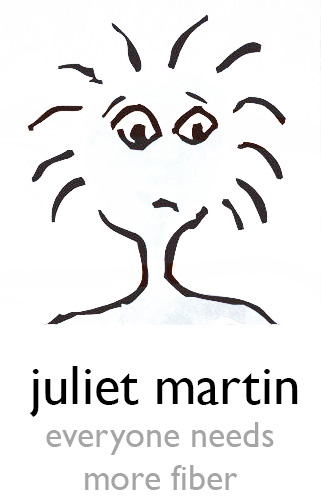I Would Wear That: A Self-absorbed Study of Non-functional Weaving
By Stephen Dandrow and Barbara Nair, Spectrum Gallery, Centerbrook, Connecticut
In Juliet Martin’s newest body of work, I Would Wear That, a collection of hand-woven sculptural wall hangings, color-coordination? Good. Functionality? Overrated. In Martin’s world, these fabrics belong on the wall, not in a laundry basket.
Is that a scarf?
No, it’s a wall hanging.
It could be a scarf.
No, it’s a wall hanging.
But it could be a scarf.
Weaving on a Japanese SAORI loom, Martin builds her fabrics into sculptures and tapestries beginning with a simple warp or vertical framework. Cut-up and reassembled, the material is stretched on ellipsoid forms with store-bought velvet and metallic cloth that peek through stressed holes in the weavings. Some are single canvases; others amalgams of smaller pieces. Loose stuffing forces out bulge-like blisters.
Through SAORI (abstract expressionism through fiber) Martin weaves until she uncovers the fabric’s “voice” by testing colors, textures, and materials. When a strong structure is revealed, she continues building to expand upon it. It is a method that bears fruit for Martin and stems from her interest in Wabi-sabi, the Japanese aesthetic and worldview of beauty – incomplete, unconventional and modest. Transience and imperfection are treasured.
Like her father, an early manager of UNIX and C++ development, who encouraged her to explore fabric art, Martin’s training in computers fosters a logical, almost scientific approach. Her starting point is a set of rules she designs and employs, such as working solely with two colors or introducing only particular textures or shapes. Respect for tradition is imbued in the work. Of course, that is until she wittingly upends this system and breaks the rules. Then, the unexpected occurs and improvisation takes over.
Both beauty and humor are infused in Martin’s work and offer a dose of irony such as in the exhibit’s signature piece, Pearl Necklace. At almost 10-foot tall, the wall hanging consists of multiple linked circular and oval shapes wrapped in colored materials not exactly reminiscent of pearls. And who wouldn’t want to don Formal Wear and Cocktail Dresses I, II and III with finely woven fabrics and sophisticated stitching, wrapped on elegant black and even showier gold and silver bases? In Outwear I, II and III, works are bulkier, with simpler patterning that portray less sensual, albeit utilitarian, masks. In Martin’s Shoe Closet, varying shapes and a wide-ranging color palette of sculptured “shoes” are on display.
Influences in Martin’s oeuvre include the American installation and performance artist Michael Kelley. His use of found objects and materials such as crocheted blankets, fabric dolls and rag toys combined in assemblages for satirical metaphor speak to her calling. The breaking of rules, such as Kelley’s incorporation of irreverent images and unexpected materials not typically seen in formalized environments, is another reminder.
Included in this catalog are pieces from Martin’s earlier collections and which were partially presented in A Show of Hands, a recent fiber arts exhibit at Spectrum Gallery in Centerbrook, Connecticut. In 38 Voices in My Head, she records 3-dimensional diary entries of questions she continually poses to herself. A palette of neutral earth tones silences brighter colors and helps the viewer focus on texture and form. In Men I Have Known, fabric phalluses represent various lovers: The European, 5 Shots Later and Why am I So Lazy? Martin notes: “Must I remember their faces? By hanging my trophies on walls, I reduce my partners to labels. The titles are the only clue to what transpired between us.”
I Would Wear That is a shift for Martin as she is less concerned with the design of the fiber, but with the shape of the sculpture as fiber interacts with form. These rigid structures contrast to the freer ones fashioned in previous works and offer Martin a broader milieu in which to explore. Through this inquiry, she provokes viewers to not only see fabric through multiple lenses – playful and fun, hard and challenging – but dares us to reflect on the notion of “What is pretty?” It may be true that Martin would “wear this” or would “wear that”. We might be willing to as well. But ultimately, her work prompts us to ask how much should we even care.
Barbara Nair is the founder and director of Spectrum Gallery in Centerbrook, CT, a nonprofit gallery which is an expansion of the Arts Center Killingworth, a nonprofit 501 (C) 3 arts organization.
Stephen Dandrow is a freelance writer, and PR and marketing specialist. He is based in New York.
Spectrum Gallery
61 Main Street
Centerbrook, CT 06409
